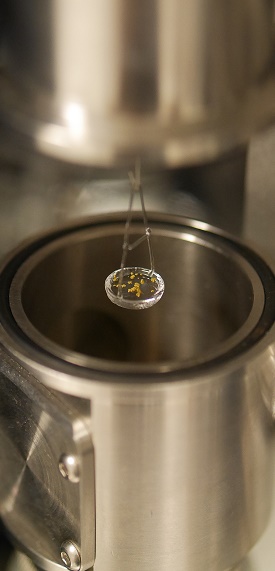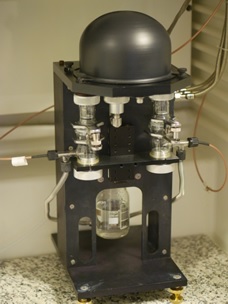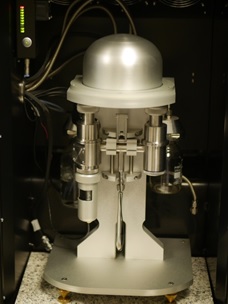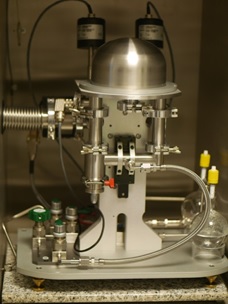
Dynamic Vapour Sorption (DVS)
Basics of the method :
Study of the mass variations of a sample placed in a closed cell that can be regulated in temperature and in solvent partial pressure. The analysis of the mass uptake curves permits thermodynamic and kinetic interpretations of solid phase stability in the investigated conditions.
Type of analyses performed (context, type of material, goals)
Three DVS apparatus are available at the SMS laboratory.
They allow to characterize ab(d)sorption/desorption phenomena, solvation/desolvation mechanisms, recrystallization (of amorphous materials or from supersaturated solutions), deliquescence and efflorescence.
Any solid materials can be analyzed by DVS (metals, polymer, organic compounds, zeolithes...)
Depending on the apparatus, several additional characterization can be envisaged
|
DVS-1 : Works only under water vapour
(temperature range : 5-45°C)
|

Picture of the apparatus
|
|
|
DVS-advantage : Works under water and some selected solvents vapours. A camera is placed directly below the sample and permits to observe the macroscopic evolution of intial solid and allows to reenforce or guide our interpretation of mass uptakes curves.
(Temperature range : 5°C to 70°C)
|

Picture of the apparatus
|

Solid sample prior analysis
|
|
DVS Vacuum : Works under vacuum or under partial pressure of solvents. Permits the simulation of filtration processes, the use of a Knudsen effusion cell is possible to obtain thermodynamic data (sublimation enthalpies, polymorphic stability)
(temperature range : 20°C to 100°C) Preheating the sample before analysis is possible up to 300°C
|

Picture of the apparatus
|
|
Contact : Yohann CARTIGNY (Assistant professor)
Highlight
-
Study of the dehydration mechanism of a pharmaceutical compound
L. Renou, S. Coste, Y. Cartigny, M-N Petit, C. Vincent, J-M Schneider, G. Coquerel , « Mechanism of hydration and dehydration of ciclopirox ethanolamine (1.1)», Crystal Growth and Design, vol 9 (2009) 3918-3927.
-
Study of a spontaneous chiral discrimination mechanism at the solid state induced by dehydration
Y. Amharar, S. Petit, M. Sanselme, Y. Cartigny, M-N Petit, G. Coquerel, “ Crystal Structures, Dehydration Mechanism, and Chiral Discrimination in the Solid State of a Hydantoin Derivative”, Crystal Growth & Design, vol 11 (2011), 2453-2462.
-
Study of the hydrate/anhydrous transition and contribution to the experimental determination of the citric acid/water phase diagram
A. Lafontaine, M. Sanselme, Y. Cartigny, P. Cardinael, G. Coquerel, Charactherization of the transition between the monohydrate and the anhydrous citric acid, Journal of Thermal Analysis and Calorimetry, vol 112 (2013), 307-315.
-
Solubility measurement of a pharmaceutical organic salt by study of its deliqiescent behavior
R. Rotival, Y. Corvis, Y. Cartigny, P. Negrier, M. Marchivie, S. Massip, I. Gana, P. Lemoine, P. Espeau, « Comprehensive Determination of the Solid State Stability of Bethanechol Chloride Active Pharmaceutical Ingredient using Combined Analytical Tools” Cryst. Eng. Comm (2013) 15, 7970-7980.
-
Obtention of a new polymorphic form by desolvatation.
B. Fours, Y. Cartigny, S. Petit, G. Coquerel, “Formation of New Polymorphs Without any Nucleation Step : Desolvation of the Rimonabant Monohydrate: Directional Crystallisation Concomitant to Smooth Dehydration”, Faraday discussion (2015), 179, 475-488
-
Patent about the obtention of a new hydrated form of a pharmaceutical compound
G. Descamps, Y.Amharar, Y. Cartigny, G. Coquerel, “Novel polymorphic form of CHDMAPP, method of preparation thereof, and pharmaceutical composition comprising same”, WO 2010/029062.


